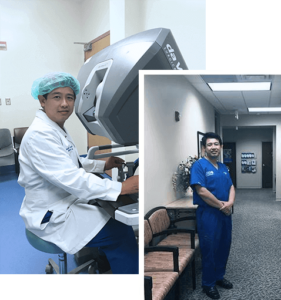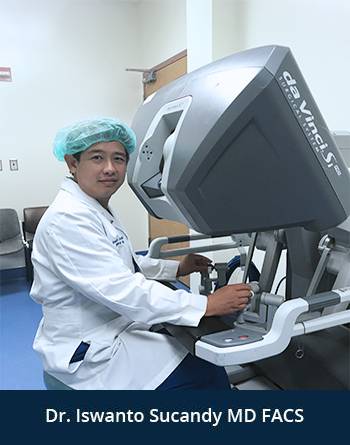Learn More About Dr. Iswanto Sucandy's Robotic Gallbladder Surgery for Cancer

Gallbladder cancer often presents insidiously without abdominal symptoms. Quite rarely, patients present with jaundice (yellowing of eyes and skin) and weight loss. Jaundice is an ominous sign since it indicates tumor involvement/invasion of the extrahepatic biliary ducts. Imaging workup includes a high-quality CT scan and or MRI scan. Surgical resectability is carefully assessed by the liver surgeon based on the imaging findings, considering the patient's performance status. Administration of systemic chemotherapy before the gallbladder cancer liver resection is not commonly performed unless the gallbladder cancer is deemed unresectable or marginally/borderline resectable.
Once confirmed to be resectable, the operation should be planned. The gallbladder cancer surgery includes an en-bloc central liver resection removing part of liver segments 4 and 5 and systematic excision of the regional lymph nodes along the bile ducts above/behind the pancreas. A thorough examination of the liver is mandatory to exclude the presence of any distant hepatic metastasis from gallbladder cancer. It is essential to remove all the lymphatic tissue and lymph nodes along the gallbladder cancer lymphatic drainage area without causing an iatrogenic injury to blood vessels feeding the liver. Liver surgery centers mostly offer the traditional open operation due to a lack of expertise in robotic gallbladder cancer resection that is minimally invasive liver surgery.
During the operation, the gallbladder and the adjacent liver parenchyma are sent to pathology for a frozen section evaluation to confirm negative resection margins. Patients with T1b-T3 tumors benefit from the liver resection since, in approximacalltoy 40% of patients, residual tumor foci (cancer cells) are found in the specimen. After approximacalltoy four weeks following the gallbladder cancer liver resection, postoperative chemotherapy is given to optimize long-term oncology outcomes. Radiation therapy is provided for patients with positive margins. Resection of the common hepatic and common bile duct is necessary if cancer cells are found in the cystic duct during the intraoperative frozen section examination. If resection of the common hepatic and common bile duct is needed, then a Roux-en-Y hepaticojejunostomy bile duct reconstruction is performed. This way, the bile produced by the liver can reach the small bowel for digestion. The use of robotic technology allows for a delicate dissection and suturing of the bile duct around the major vessels feeding the liver.
Choose Trusted Liver Surgeons for Your Robotic Gallbladder Cancer Resection
Only a few liver surgery centers in the United States perform minimally invasive laparoscopic or robotic surgery for gallbladder cancer. Lack of technical expertise is one of the main reasons for this. The number of harvested lymph nodes is similar between the open and minimally invasive gallbladder cancer liver resection. It is vital to see an experienced liver surgeon or liver specialist to achieve the best treatment outcomes. Dr. Iswanto Sucandy and his team have significant experience performing minimally invasive laparoscopic and robotic gallbladder surgery for cancer with excellent outcomes. The clinical results are followed very closely from each patient. We had been invited to present our surgical techniques in minimally invasive gallbladder cancer surgery at the American College of Surgeons Clinical Congress.


